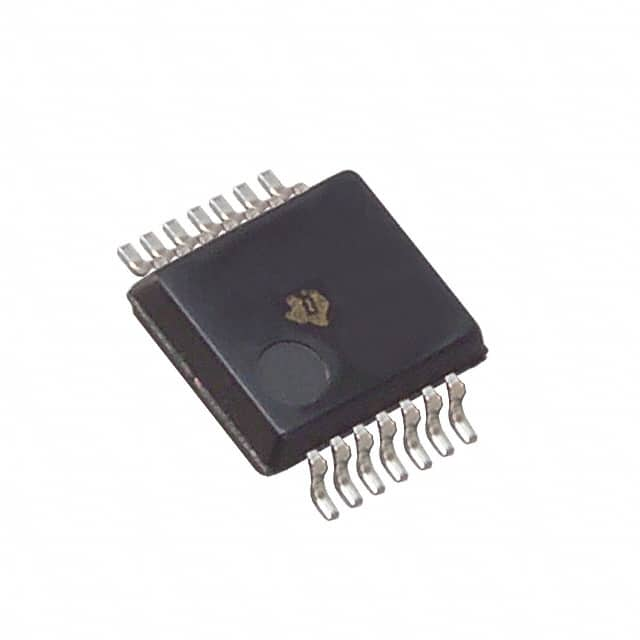Viz Specifikace pro podrobnosti o produktu.

SN74LVC14ADBR
Overview
Category: Integrated Circuit (IC)
Use: The SN74LVC14ADBR is a hex inverter with Schmitt-trigger inputs. It is commonly used for signal processing and voltage level conversion in various electronic devices.
Characteristics: - Hex inverter with Schmitt-trigger inputs - Low-voltage CMOS technology - High-speed operation - Wide operating voltage range - Schmitt-trigger hysteresis for noise immunity
Package: SSOP-14
Essence: The SN74LVC14ADBR is an essential component in digital logic circuits, providing reliable and efficient signal inversion with noise tolerance.
Packaging/Quantity: The SN74LVC14ADBR is typically packaged in reels or tubes, with a quantity of 2500 units per reel/tube.
Specifications
- Supply Voltage Range: 1.65V to 5.5V
- Input Voltage Range: 0V to VCC
- Output Voltage Range: 0V to VCC
- Maximum Operating Frequency: 50MHz
- Propagation Delay Time: 4.3ns (typical)
- Input Capacitance: 2pF (typical)
- Operating Temperature Range: -40°C to +85°C
Pin Configuration
The SN74LVC14ADBR has a total of 14 pins arranged as follows:
__ __
1 | 1 \/ 14 | VCC
2 | 2 13 | A
3 | 3 12 | Y
4 | 4 11 | B
5 | 5 10 | GND
6 | 6 9 | C
7 | 7 8 | Y
-- --
Functional Features
- Hex inverter: Provides six independent inverters in a single package.
- Schmitt-trigger inputs: Ensures noise immunity and stable output even in the presence of input signal fluctuations.
- Low-voltage CMOS technology: Enables operation at low power supply voltages, making it suitable for battery-powered devices.
- High-speed operation: Allows for fast signal processing and response times.
- Wide operating voltage range: Supports a broad range of input and output voltage levels.
Advantages
- Noise immunity: The Schmitt-trigger inputs enhance the circuit's ability to reject noise and provide reliable signal inversion.
- Compact design: The integration of six inverters in a single package saves board space and simplifies circuit layout.
- Low power consumption: The use of low-voltage CMOS technology enables efficient operation with minimal power consumption.
- Versatility: The SN74LVC14ADBR can be used in various applications requiring signal inversion and voltage level conversion.
Disadvantages
- Limited output current: The SN74LVC14ADBR has a relatively low output current capability, which may restrict its use in certain high-current applications.
- Temperature limitations: The operating temperature range of -40°C to +85°C may not be suitable for extreme temperature environments.
Working Principles
The SN74LVC14ADBR operates by receiving an input signal and producing the inverted output signal. The Schmitt-trigger inputs ensure that the output transitions occur at specific voltage thresholds, providing noise immunity and stable output even in the presence of input signal fluctuations.
Detailed Application Field Plans
The SN74LVC14ADBR finds application in various fields, including:
- Digital logic circuits: It is commonly used for signal inversion and voltage level conversion in microcontrollers, digital processors, and communication systems.
- Sensor interfaces: The SN74LVC14ADBR can be employed to interface sensors with different voltage levels, ensuring compatibility and reliable signal processing.
- Industrial automation: It is utilized in control systems, PLCs (Programmable Logic Controllers), and motor drives for signal inversion and level shifting.
Detailed and Complete Alternative Models
- SN74LVC04A: Hex inverter without Schmitt-trigger inputs.
- SN74LVCH14A: Hex inverter with Schmitt-trigger inputs and 5V-tolerant inputs.
- SN74LVC06A: Hex inverter with open-drain outputs.
These alternative models offer similar functionality but may have different specifications or package options.
In conclusion, the SN74LVC14ADBR is a versatile hex inverter IC with Schmitt-trigger inputs. Its high-speed operation, noise immunity, and low-voltage CMOS technology make it suitable for various digital logic applications. However, its limited output current and temperature limitations should be considered when selecting this component for specific designs.
Seznam 10 běžných otázek a odpovědí souvisejících s aplikací SN74LVC14ADBR v technických řešeních
Sure! Here are 10 common questions and answers related to the application of SN74LVC14ADBR in technical solutions:
Q: What is SN74LVC14ADBR? A: SN74LVC14ADBR is a hex inverter with Schmitt-trigger inputs, which means it can convert low-level signals to high-level signals and vice versa.
Q: What is the voltage range supported by SN74LVC14ADBR? A: SN74LVC14ADBR supports a voltage range from 1.65V to 5.5V.
Q: Can SN74LVC14ADBR be used for level shifting between different voltage domains? A: Yes, SN74LVC14ADBR can be used for level shifting between different voltage domains due to its wide voltage range support.
Q: How many inverters are there in SN74LVC14ADBR? A: SN74LVC14ADBR has six inverters in a single package.
Q: What is the maximum output current that SN74LVC14ADBR can provide? A: SN74LVC14ADBR can provide a maximum output current of 32mA.
Q: Is SN74LVC14ADBR suitable for high-speed applications? A: Yes, SN74LVC14ADBR is suitable for high-speed applications as it has a propagation delay of only a few nanoseconds.
Q: Can SN74LVC14ADBR tolerate overvoltage conditions? A: No, SN74LVC14ADBR is not designed to tolerate overvoltage conditions. It is recommended to stay within the specified voltage range.
Q: Does SN74LVC14ADBR have built-in protection features? A: Yes, SN74LVC14ADBR has built-in ESD protection on all inputs and outputs.
Q: Can SN74LVC14ADBR be used in battery-powered applications? A: Yes, SN74LVC14ADBR can be used in battery-powered applications as it supports a wide voltage range, including lower voltages.
Q: What is the package type of SN74LVC14ADBR? A: SN74LVC14ADBR comes in a small-outline integrated circuit (SOIC) package.
Please note that these answers are general and may vary depending on specific application requirements.

